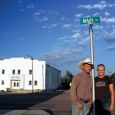The Gift of South Dakota
Subscriptions to South Dakota Magazine make great gifts!
Subscribe today — 1 year (6 issues) is just $29!
Did Herrick Really Have a Stone Man?
Nov 2, 2011
I’ll admit, it sounded fishy as soon as I finished reading it. I was paging through The Saga of Sully Flats, Adeline Gnirk’s history book about Gregory County, when I found a picture of what appeared to be a cement human figure. The paragraph below the photo identified it as a petrified man that had been discovered in a sandpit south of Herrick. “With the exception of a cracked arm and leg, the stone man was well preserved,” the writer said. The book went on to say the man had been claimed by a museum in the East. And that was the end of the story.
A Google search produced nothing, but a conversation with a friend supported my initial suspicion. “I bet it was a hoax,” he told me.
Petrified humans were a popular hoax during the 1800s. Accounts of new discoveries appeared in newspapers with some regularity. Many stories were simply created by the editors, who wanted to sell more papers and carry more exciting content than their rivals.
One of the most famous examples is the Cardiff Giant, a 10-foot petrified human figure discovered near Cardiff, N.Y., in 1869. Tobacco peddler George Hull convinced a German stonecutter in Iowa to carve the likeness, telling him it was intended for a monument to Abraham Lincoln. Hull, an atheist, was upset after an argument at a Methodist revival over a Bible verse that claimed giants once roamed the Earth. He spent $2,600 on the hoax.
A group of South Dakotans fooled thousands of people with a faked petrified man at the 1893 World’s Fair in Chicago. The idea belonged to William Sutton, a butcher at Forest City, who enlisted help from William Horn and James Sutton. The men traveled to Redfield, where James Sutton allowed a cast to be made of his body. Inside, they placed a human skeleton (makes you wonder where they got the bones) and filled it with cement. Then they buried the body along the Little Cheyenne River near Forest City. Later, while out searching for limestone, Horn “discovered” the body, which was exhumed and came to be known as the “Forest City Man.”
I called Jack Broome, the retired Burke school superintendent and local historian. If anyone would know the story behind Herrick’s stone man, it would be Broome. But I was out of luck. “In all my years around here, I’ve never heard much about it,” he told me, though he added that he wouldn’t be surprised to learn it was a hoax. “They even faked the gold rush out here,” he said. “There was a little town called St. Elmo near Herrick. Settlers claimed they discovered gold, but they hadn’t. They were just trying to get people to settle that area.”
All signs point to Herrick’s stone man being the product of a group of clever settlers who got caught up in a fad. But no one can say with certainty. Can you?











Comments
I'm not sure what thought process would lead someone to store a 10,000 year old man in one's basement.